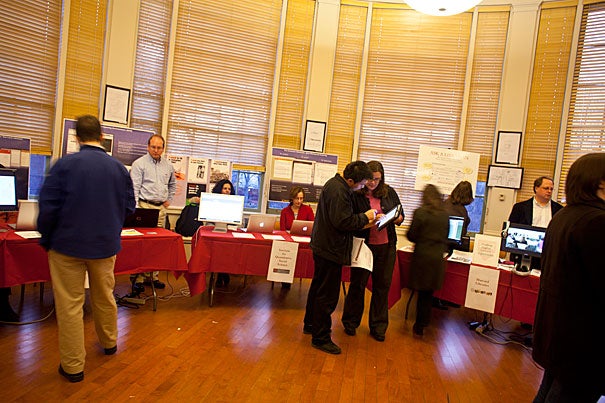
Harvard Libraries and the Derek Bok Center for Teaching and Learning were among the 23 Harvard organizations that participated in the Arts & Humanities and Social Science Digital Technology Fair.
Justin Ide/Harvard Staff Photographer
What’s possible
Fair highlights Harvard’s digital resources
Students and faculty interested in the online archive of Byzantine seals at Dumbarton Oaks, ways to digitally engage with Harvard Art Museums’ artworks, or video links to professors in different time zones only had to visit Harvard’s Barker Center on Nov. 29.
There, from 3:30 to 6 p.m., a feast of digital technology was on display at the annual Arts & Humanities and Social Science Digital Technology Fair.
The fair, in its third year, is an effort to highlight the wide range of digital resources available to scholars and students for teaching and research.
Representatives from Harvard Libraries, the Faculty of Arts and Sciences (FAS) IT Academic Technology Group, FAS IT Services and Support Group, and the Derek Bok Center for Teaching and Learning were among the 23 Harvard organizations on hand to explain their digital projects and services.
Alexander F. Parker, director of research computing in the humanities, has helped develop and run the fair since 2007, when Harvard Dean of Arts and Humanities Diana Sorensen charged him with developing an event that would showcase the range of services in the “digital domain” for students and faculty in FAS.
“The challenge is to make people aware of what’s available,” said Parker, who worked in tandem on this year’s fair with Jennifer Shephard, special initiatives program manager in Harvard’s social science division. “We are getting better at letting faculty know where to go for what need they might have. That has been a driver behind our events.”
Amy Thompson and her group help professors and students connect directly with technology in the classroom. Thompson directs the Media & Technology Services part of Instructional Media Services at FAS and assists with everything from projectors in classrooms to video conferencing.
Thompson displayed some of her department’s audio and visual efforts, and explained how a volcano featured prominently in recent work.
When ash from the erupting Eyjafjallajökull volcano in Iceland in April closed European airspace for several days and stranded a number of Harvard professors overseas, Thompson and her team connected professors with their classes through the magic of video feeds.
“We helped the students stay right up with the syllabus by connecting them to their professors remotely.”
Elaheh Kheirandish, a fellow at Harvard’s Center for Middle Eastern Studies, hopes her work will help inspire faculty and students by offering them a more nuanced look at the development of science in Islamic lands through interactive maps that chart the course of exploration and conquest in the Middle East. One of the 23 exhibitors at this year’s fair, she displayed on a computer screen a series of color-coded maps of the Middle East from 700 to 1750, part of her Micromapping Early Science project.
“I am interested in the ways technology can drive the research,” said Kheirandish, a science historian and mathematician.
“Ideally, my hope is that this work generates research questions we would not have thought of without this technology.”
Professor Thomas Kelly, Harvard’s Morton B. Knafel Professor of Music, made a swing through the exhibits on Monday. One of the early adopters of a course website at Harvard and familiar with trying to make audio digitally available to his students, Kelly was inspired to see so many people interacting with the technology and one another.
“I think this is wonderful. It’s always good to find out what’s possible, what someone else has thought of that you haven’t.”




